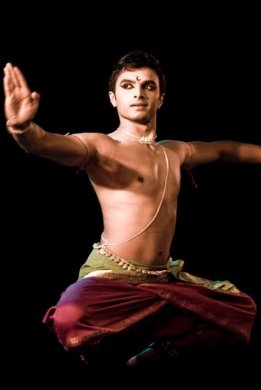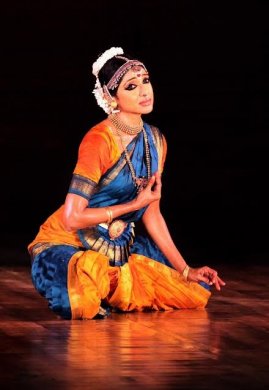
|   |

|   |
 e-mail: leelakaverivenkat@gmail.com Encouraging audiences for the ticketed Divinity Series Photos courtesy: Jyotsna Shourie Dance Centre April 26, 2017 For long, one has heard persons declaring from varied platforms that dance performances thrown open for free to the public at large over the years, has not just devalued the art, but also spoilt audiences, almost creating in them a feeling of entitlement. Little, however, has been done to change the situation. In the circumstances, taking the plunge to make a ticketed show of the 'Divinity Series' (held this year from April 6 - 8 at the Habitat Stein Auditorium, Delhi) annually mounted by Jyotsna Shourie Dance Centre, was a step in the right direction - and on the second and third evenings I attended, the satisfyingly full auditorium was reassuring that having to pay was no deterrent, provided the concerned event held promise of quality performances. One heard from the organiser that even on the first evening featuring a known Delhi artist Vidha Lal (in what till now has been a Bharatanatyam oriented festival) there was a decent sized audience with over a hundred tickets sold.  Parshwanath Upadhye A Karate black belt and yoga specialist, the much-in-demand Bangalore based Bharatanatyam dancer Parshwanath Upadhye has been dazzling audiences with his virtuosity, the geometry of the Bharatanatyam technique translating into visual delight in this dancer's leaps and immaculate lines. But having made this statement, one wished his performances could feature more of the well known margam repertoire - instead of always going in for unusual items. Even the invocation to Saraswati, Lakshmi and Ganapati through well known hymns like "Yakundendu tusharahara dhavala...." and "Namastestu mahamaye sree pithe surapoojite", with K. Venkateshwar's moving vocal support in Kamas and Desh, the overlong, connecting nritta interludes punctured the serenity of a starting prayer. In full flow in the varnam "Ananda Nandi" based on a ragamalika composition (libretto and music by Arjun Bhardwaj), unlike the conventional sringar based centrepiece, what one saw was a rare theme developed round the intense devotional journey of Nandikeswara, the vahana of Shiva and guardian of his abode. Nandi as an ardent devotee of Shiva no other gana can equal, has several facets to his personality, captured in the dance narrative. A mridangist who accompanies the dance of Shiva, the "tat dhit tom nom" (Nandichol) syllables are attributed to him. He is treated to the wonder of Shiva's tandav dance, with karanas like Bhujanga-trastarecitam, Vidyutbhrantam, Vrishabhakriditam, Visnukrantam, Dandapadam and others flowing out of his movements (chapter on karanas originally formed part of Nandikeswara's Bharatarnava). For this critic the confusing part was the final Nandikeswara's Abhinaya Darpana theory being visualised in segments - beginning with the "Angikam Bhuvanam" prayer, the hasta mudras, padabhedas, the chaturvidha abhinayas and what have you, where lines between the myth of Nandi, and textual theory propounded in Nandikeswara's Abhinaya Darpana got somewhat mixed. Nandikeswara of Bharatarnava and Abhinaya Darpana was a scholar from the Andhra region according to scholars. The interspersed challenging teermanams with the movements symbolising the horned bull, with the interpretative parts strung through a passage of myriad ragas like Kalyani, Charukesi, Ranjani, Sindhu Bhairavi etc. the varnam became a roller coaster ride through bhakti and high nritta. Ringing applause followed, predictably, from an enraptured audience. But somewhere notwithstanding the razzle- dazzle and the dancer's involved and enviable command over technique, this very elaborately conceived varnam, while spectacular, did not strike the inner chord of this critic like a traditional varnam can with its architectonic build-up of sringar intensity. To watch Parshwanath interpret a Quartet varnam would be interesting. Holding an audience through delineation of oft presented fare poses a greater challenge. Purandaradasa's "Baro Krishnaiyya" starting with the delightful Maand, before changing over to other ragas, was interpreted with involvement. Male Bharatanatyam dancers generally avoid Padams. I would be very interested in watching Upadhye's interpretation of a Padam - or a Gita Govinda ashtapadi. Finally, he must learn to programme his recital better. With two Devarnamas planned, one had to be dropped and even then he went far beyond the allotted time limit. The Balamurali gatibheda Rasika Priya Tillana brought down the curtain on a virtuosity filled evening.  Meenakshi Srinivasan Bharatanatyam dancer Meenakshi Srinivasan has been featured in the Divinity Series earlier too. The invocation to Parashakti, the consort of Shiva, and the primordial source of all energy made for a tranquil start to the programme. Very much in the traditional varnam mould, the full flowering of Meenakshi's Bharatanatyam was seen in the rendition of Guru Dandayudapani Pillai's Karaharapriya varnam "Mohamaginen" wherein the lovelorn nayika confides in her sakhi about her deep longing for the Lord of Chidambaram. Nature with its flowers and creatures seems to echo the nayika's varied feelings, thwarted as she is by the flowered darts of Manmatha. The yearning feeling in the first half, in the charanam suddenly changes to one of assertive fearlessness, wherein the nayika declares that her love is no secret and she is not afraid of others knowing about it. While the dancer's interpretative dance was communicative, Hariprasad's very involved singing also provided strong support with K.S. Balakrishnan's nattuvangam, G. Ganesan on the mridangam and T. Sashidhar on flute. "Agni Praveshsam" has now become the signature item of this dancer with the Tamil translation of Valmiki Ramayanam, the music by Hariprasad which is given enough space to register mood with each raga and Meenakshi's intelligently conceived minimalistic dance interpretation - all adding up to an extremely moving item. Lifting one from the sombre mood came the lilting Bilahari of the Tillana, with its concluding couplet on life-giving rain from the Tirukkural.  Writing on the dance scene for the last forty years, Leela Venkataraman's incisive comments on performances of all dance forms, participation in dance discussions both in India and abroad, and as a regular contributor to Hindu Friday Review, journals like Sruti and Nartanam, makes her voice respected for its balanced critiquing. She is the author of several books like Indian Classical dance: Tradition in Transition, Classical Dance in India and Indian Classical dance: The Renaissance and Beyond. Post your comments Please provide your name and email id when you use the Anonymous profile in the blog to post a comment. All appropriate comments posted with name & email id in the blog will also be featured in the site. |